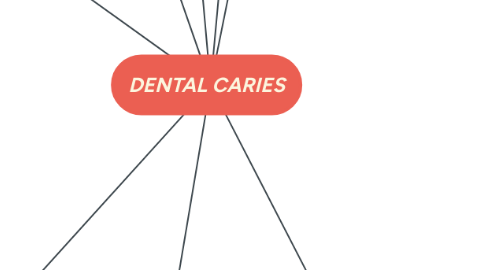
1. 5-DEMINERALIZATION AND REMINERALIZATION OF ENAMEL (Caries Balance)
1.1. Demineralization phase (chemistry of enamel caries)
1.2. Phase of remineralization
2. 6-PATHOLOGY OF DENTAL CARIES
2.1. ENAMEL CARIES
2.1.1. Macroscopic appearance
2.1.2. Microscopic appearance
2.1.2.1. phase of INITIATION
2.1.2.1.1. Methods to identify phase of initiation
2.1.2.1.2. Translucent zone
2.1.2.1.3. Dark zone
2.1.2.1.4. Body of the lesion
2.1.2.1.5. Surface Zone
2.1.2.2. phase of BACTERIAL INVASION
2.1.2.3. phase of DESTRUCTION
2.1.2.4. phase of SECONDARY ENAMELCARIES
2.2. DENTIN CARIES
2.2.1. Comp. of dentin
2.2.2. Macroscopic feature
2.2.3. Microscopic Features
2.2.3.1. Uninfected dentinal Lesion (acid attack)
2.2.3.1.1. Zone of fatty degeneration
2.2.3.1.2. Zone of Hypermineralization
2.2.3.1.3. Zone of Hypomineralization
2.2.3.2. Infected Dentinal Lesion (bacterial invasion) Main bulk
2.2.3.2.1. Pioneers
2.2.3.2.2. Beading
2.2.3.2.3. Liquefaction foci and transverse cleft
2.2.3.3. Area of Dentinal Destruction (superficial zone)
3. 7-ROOT SURFACE CARIES(CEMENTUM)
4. 8-THEORIES OF DENTIN CARIES
5. 4-DENTAL PLAQUE
5.1. Def.
5.2. Compisiton
5.3. Mechanism Of formation
5.3.1. Formation of acq. enamel pellicle
5.3.2. Colonization of cell free pellicle by bacteria (dental plaque)
5.3.2.1. Initial community
5.3.2.2. Intermediate community
5.3.2.3. Mature community (Climax Community)
5.4. Role of plaque matrix
5.5. Factors Affecting plaque formation
5.6. Formation and Function of extracellular polysaccharides
5.7. Formation and Function of intracellular polysaccharide (Amylopecitin)
5.8. STEPHANS EXPIREMENT (prove imp. of acid prod. in dental plaque)
5.8.1. CHO rinse -->rapid fall in PH
5.8.2. Critical pH 5.5 --> demineralization of enamel
5.8.3. slowly inc. in pH supersaturated plaque--> remineralization
6. 1-DEF
7. 2-TYPES
7.1. SITE
7.2. STAGE
7.3. PROGRESSION
8. 3-ETIOLOGY OF DENTAL CARIES
8.1. Host
8.1.1. Suspectible tooth
8.1.1.1. Position
8.1.1.2. Morphology
8.1.1.2.1. pits and fissures (Shape and Depth)
8.1.1.2.2. Contact Areas (young and adults)
8.1.1.3. Structure
8.1.1.3.1. Enamel hypoplasia &hypocalcification (rate only not initiation)
8.1.1.3.2. Newly Erupted more caries suspectible but later caries resistance increase
8.1.1.4. Flourides
8.1.1.4.1. Supply
8.1.1.4.2. Mechanism
8.1.1.5. Genetic Factor
8.1.2. Saliva
8.1.2.1. Washing effect (flow rate)
8.1.2.2. Salivary glycoproteins(viscosity)
8.1.2.3. buffering capacity
8.1.2.4. Antibacterial effect
8.2. Substrate (Fermentable Carbohydrate)
8.2.1. Types
8.2.1.1. Monosacharide
8.2.1.2. Disaccharide MOST CARIOGENIC (SUCROSE ARCH OFCRIMINAL CARIES)
8.2.1.2.1. Diff bt. levan and dextran
8.2.1.3. Polysaccharides (least cariogenic)
8.2.1.4. Sugar Alcohol
8.2.2. Total amount of carbs intake
8.2.3. Frequency of carbs intake
8.2.4. Texture of carbs
8.2.5. Local effect of carbs (ONLY when introduced directly to oral cavity)
8.2.6. Refinement of carbs
8.2.7. TURKUSTUDY 1976 (diff. caries rate by various sugars
8.2.7.1. Sucrose highly cariogenic
8.2.7.2. Frutose less cariogenic
8.2.7.3. No caries with xylitol
8.2.7.3.1. XYLITOL ANTICARIOGENIC (bacteria is unable to ferment it)
8.2.7.3.2. HONEY HIGHLY CARIOGENIC (not refined)
8.2.8. VIPEHOLM STUDY 1945-1953 (effect of Amount,Freq,texture of carbs on caries)
8.2.8.1. inc. sugar->inc. caries
8.2.8.2. more time sticky-> more risk
8.2.8.3. CHO bt. meals -> more risk
8.2.9. HOPEWOOD HOUSE EXPIREMENT1948-1963 (diet of children at home vs. children in average australian household would affect caries)
8.2.9.1. Low Caries incidence at hopehousehold when left caries increase
8.3. Cariogenic Bacteria
8.3.1. CHARACTERISTIC FEAUTURES OF CARIOGENIC BACTERIA
8.3.2. STREPTOCCOUS MUTANS
8.3.3. LACTOBACILLI
8.3.4. MILLERS 1890
8.3.4.1. Bacteria-->Acids-->demineralization of enamel and dentin
8.3.4.2. Bacteria didn't need to be present to initiate demineralization
8.3.5. ORLANDS EXPIREMENT 1954
8.3.5.1. PROD.OF GERM FREE ANIMALS (is bacteria essential fo caries?)
8.3.5.1.1. Bacteria is essential
8.3.5.2. PROD. OF GNOTOBIOTES (do all produce dental caries and which ones produce more)
8.3.5.2.1. No not all of them. Strept more cariogenic that lactobacilli
